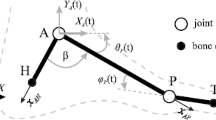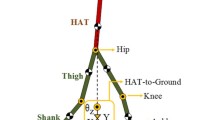Abstract
Foot–ground contact models are an important part of forward dynamic biomechanic models, particularly those used to model gait, and have many challenges associated with them. Contact models can dramatically increase the complexity of the multibody system equations, especially if the contact surface is relatively large or conforming. Since foot–ground contact has a large potential contact area, creating a computationally efficient model is challenging. This is particularly problematic in predictive simulations, which may determine optimal performance by running a model simulation thousands of times. An ideal contact model must find a balance between accuracy for large, conforming surfaces, and computational efficiency.
Volumetric contact modelling is explored as a computationally efficient model for foot–ground contact. Previous foot models have used volumetric contact before, but were limited to 2D motion and approximated the surfaces as spheres or 2D shapes. The model presented here improves on current work by using ellipsoid contact geometry and considering 3D motion and geometry. A gait experiment was used to parametrise and validate the model. The model ran over 100 times faster than real-time (in an inverse simulation at 128 fps) and matched experimental normal force and centre of pressure location with less than 7% root-mean-square error.
In most gait studies, only the net reaction forces, centre of pressure, and body motions are recorded and used to identify parameters. In this study, contact pressure was also recorded and used as a part of the identification, which was found to increase parameter optimisation time from 10 to 164 s (due to the additional time needed to calculate the pressure distribution) but helped the results converge to a more realistic model. The model matched experimental pressures with 33–45% root-mean-square error, though some of this was due to measurement errors.
The same parametrisation was done with friction included in the foot model. It was determined that the velocity-based friction model that was used was inappropriate for use in an inverse-dynamics simulation. Attempting to optimise the model to match experimental friction resulted in a poor match to the experimental friction forces, inaccurate values for the coefficient of friction, and a poorer match to the experimental normal force.












Similar content being viewed by others
References
Anderson, F.C., Pandy, M.G.: Dynamic optimization of human walking. J. Biomech. Eng. 123(5), 381–390 (2001)
Peasgood, M., Kubica, E., McPhee, J.: Stabilization of a dynamic walking gait simulation. J. Comput. Nonlinear Dyn. 2(3), 65–72 (2007)
Smith, C.R., Vignos, M.F., Lenhart, R.L., Kaiser, J., Thelen, D.G.: The influence of component alignment and ligament properties on tibiofemoral contact forces in total knee replacement. J. Biomech. Eng. 138(5), 021017 (2016)
Fregly, B.J., Reinbolt, J.A., Rooney, K.L., Mitchell, K.H., Chmielewski, T.L.: Design of patient-specific gait modifications for knee osteoarthritis rehabilitation. IEEE Trans. Biomed. Eng. 54(9), 1687–1695 (2007)
Allen, S.J., King, M.A., Yeadon, M.R.: Optimisation of phase ratio in the triple jump using computer simulation. Hum. Mov. Sci. 46, 167–176 (2016)
Halloran, J.P., Ackermann, M., Erdemir, A., van den Bogert, A.J.: Concurrent musculoskeletal dynamics and finite element analysis predicts altered gait patterns to reduce foot tissue loading. J. Biomech. 43(14), 2810–2815 (2010)
Saraswat, P., Andersen, M.S., MacWilliams, B.A.: A musculoskeletal foot model for clinical gait analysis. J. Biomech. 43, 1645–1652 (2010)
Fluit, R., Andersen, M.S., Kolk, S., Verdonschot, N., Koopman, H.F.J.M.: Prediction of ground reaction forces and moments during various activities of daily living. J. Biomech. 47(10), 2321–2329 (2014)
Skals, S., Jung, M.K., Damsgaard, M., Andersen, M.S.: Prediction of ground reaction forces and moments during sports-related movements. Multibody Syst. Dyn. 39(3), 175–195 (2017)
Font-Llagunes, J.M., Barjau, A., Pàmies-Vilà, R., Kovecses, J.: Dynamic analysis of impact in swing-through crutch gait using impulsive and continuous contact models. Multibody Syst. Dyn. 28(3), 257–282 (2012)
Ros, J., Font-Llagunes, J.M., Plaza, A., Kovecses, J.: Dynamic considerations of heel-strike impact in human gait. Multibody Syst. Dyn. 35(3), 215–232 (2015)
Pérez-Gonzâlez, A., Fenollosa-Esteve, C., Sancho-Bru, J.L., Sanchez-Marfn, F.T., Vergara, M., Rodrfguez-Cervantes, P.J.: A modified elastic foundation contact model for application in 3D models of the prosthetic knee. Med. Eng. Phys. 30(3), 387–398 (2008)
Flores, P., Machado, M., Silva, M.T., Martins, J.M.: On the continuous contact force models for soft materials in multibody dynamics. Multibody Syst. Dyn. 25(3), 357–375 (2011)
Mahboobin, A., Cham, R., Piazza, S.J.: The impact of a systematic reduction in shoe-floor friction on heel contact walking kinematics—a gait simulation approach. J. Biomech. 43, 1532–1539 (2010)
Lopes, D.S., Neptune, R.R., Ambrósio, J.A., Silva, M.T.: A superellipsoid-plane model for simulating foot–ground contact during human gait. Comput. Methods Biomech. Biomed. Eng. 19(9), 954–963 (2016)
Jackson, J.N., Hass, C.J., Fregly, B.J.: Development of a subject-specific foot- ground contact model for walking. J. Biomech. Eng. 138(9), 091002 (2016)
Moreira, P., Silva, M., Flores, P.: Ground foot interaction in human gait: modelling and simulation. In: Proceedings of 7th EUROMECH Solid Mechanics Conference, 7–11 September Lisbon, Portugal (2009)
Millard, M., Kecskeméthy, A.: A 3D foot–ground model using disk contacts. In: The 3rd Joint International Conference on Multibody System Dynamics & The 7th Asian Conference on Multibody Dynamics, Busan, Korea (2014)
Gonçalves, A.A., Bernardino, A., Jorge, J., Lopes, D.S.: A benchmark study on accuracy-controlled distance calculation between superellipsoid and superovoid contact geometries. Mech. Mach. Theory 115, 77–96 (2017)
Gonthier, Y., McPhee, J., Lange, C., Piedbœuf, J.-C.: A contact modeling method based on volumetric properties. In: ASME IDETC, Long Beach, California, USA pp. 477–486 (2005)
Boos, M., McPhee, J.: Volumetric modeling and experimental validation of normal contact dynamic forces. J. Comput. Nonlinear Dyn. 8(2), 021006 (2013)
Gonthier, Y.: Contact dynamics modelling for robotic task simulation. Ph.D. Thesis, University of Waterloo (2007)
Millard, M., McPhee, J., Kubica, E.: Multi-step forward dynamic gait simulation. In: Bottasso, C.L. (ed.) Multibody Dynamics: Computational Methods and Applications, pp. 25–43. Springer, Dordrecht (2009)
Sharif Shourijeh, M., McPhee, J.: Forward dynamic optimization of human gait simulations: a global parameterization approach. J. Comput. Nonlinear Dyn. 9(3), 031018 (2014)
Shourijeh, M.S., McPhee, J.: Foot-ground contact modeling within human gait simulations: from Kelvin–Voigt to hyper-volumetric models. Multibody Syst. Dyn. 35(4), 393–407 (2015)
Mouzo, F., Lugrfs, U., Pàmies-Vilà, R., Font-Llagunes, J.M., Cuadrado, J.: Underactuated approach for the control-based forward dynamic analysis of acquired gait motions. In: ECCOMAS Thematic Conference on Multibody Dynamics, Barcelona, Catalonia, Spain (2015)
Brown, P.: Contact modelling for forward dynamics of human motion. Master’s thesis, University of Waterloo (2017)
Brown, P., McPhee, J.: Volumetric contact model of ellipsoid-plane geometries. In: ECCOMAS Thematic Conference on Multibody Dynamics (2017)
Pàmies-Vilà, R., Font-Llagunes, J.M., Lugrfs, U., Cuadrado, J.: Parameter identification method for a three-dimensional foot–ground contact model. Mech. Mach. Theory 75, 107–116 (2014)
Gerus, P., Sartori, M., Besier, T.F., Fregly, B.J., Delp, S.L., Banks, S.A., Pandy, M.G., D’Lima, D.D., Lloyd, D.G.: Subject-specific knee joint geometry improves predictions of medial tibiofemoral contact forces. J. Biomech. 46(16), 2778–2786 (2013)
Wesseling, M., De Groote, F., Bosmans, L., Bartels, W., Meyer, C., Desloovere, K., Jonkers, I.: Subject-specific geometrical detail rather than cost function formulation affects hip loading calculation. Comput. Methods Biomech. Biomed. Eng. 19(14), 1475–1488 (2016)
Hannah, I., Sawacha, Z., Guiotto, A., Mazzà, C.: Relationship between sagittal plane kinematics, foot morphology and vertical forces applied to three regions of the foot. Int. Biomech. 3(1), 50–56 (2016)
Zhu, J., Wang, Q., Wang, L.: On the design of a powered transtibial prosthesis with stiffness adaptable ankle and toe joints. IEEE Trans. Ind. Inform. 61(9), 4797–4807 (2014)
Brown, P., McPhee, J.: A continuous velocity-based friction model for dynamics and control with physically meaningful parameters. J. Comput. Nonlinear Dyn. 11(5), 054502 (2016)
Li, K.W., Wen, H.C.: Friction between foot and floor under barefoot conditions: a pilot study. In: IEEE International Conference on Industrial Engineering and Engineering Management, pp. 1651–1655 (2014)
Gronqvist, R., Abeysekera, J., Gard, G., Hsiang, S.M., Leamon, T.B., Newman, D.J., Gielo-Perczak, K., Lockhart, T.E., Pai, C.Y.: Human-centred approaches in slipperiness measurement. Ergonomics 44(13), 1167–1199 (2001)
Acknowledgements
This research was funded by the Natural Sciences and Engineering Research Council of Canada and the Canada Research Chairs program.
Special thanks to Dr. Stacey Acker and David Kingston for the use of their lab space and assistance running the gait experiments.
Author information
Authors and Affiliations
Corresponding author
Rights and permissions
About this article
Cite this article
Brown, P., McPhee, J. A 3D ellipsoidal volumetric foot–ground contact model for forward dynamics. Multibody Syst Dyn 42, 447–467 (2018). https://doi.org/10.1007/s11044-017-9605-4
Received:
Accepted:
Published:
Issue Date:
DOI: https://doi.org/10.1007/s11044-017-9605-4




